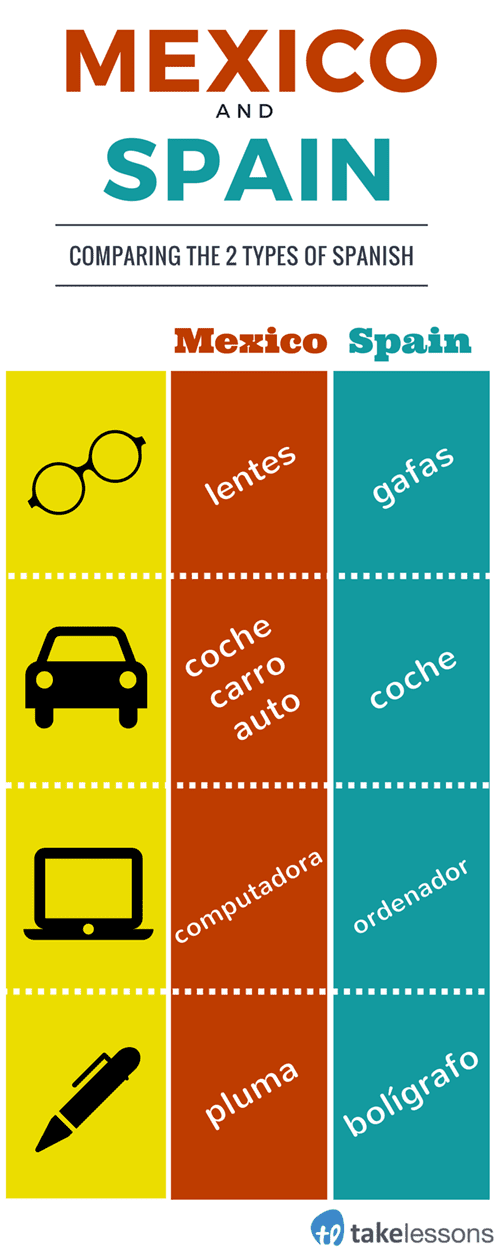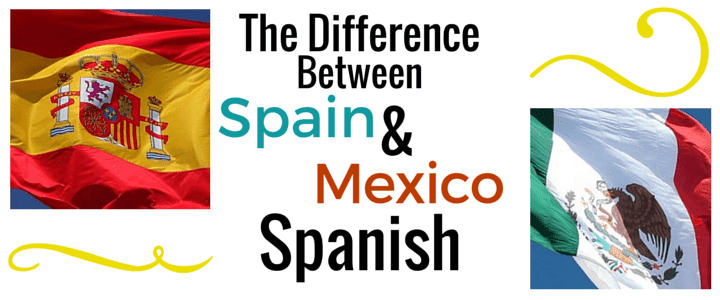If you are learning Spanish using books, apps, and other materials, you may have noticed some slight discrepancies in grammar, vocabulary, and pronunciation. Why are there differences and how can you differentiate between them when you’re learning?
The reason for this is the difference between Spanish used in Mexico and Spanish used in Spain. Though they speak Spanish in Mexico and Spain, you will come across many differences between Spanish and Mexican variations. The Spanish language spoken in Spain is called Castilian Spanish. In fact, it is considered the official Spanish language, which you will most commonly hear spoken in northern and central Spain.
Now, what language does Mexico speak? This style of Spanish is referred to as Latin American Spanish or Mexican Spanish. It’s most often spoken in Central and South America.
So are Spanish and Mexican the same? Yes and no. To better understand the differences and nuances when it comes to Mexican Spanish vs. Spain Spanish, you might consider U.K. English vs. American English. At the end of the day, it’s the same language, but you’ll find many different pronunciations, vocabulary, and even spelling between the two. For example, in the U.K., they might say holiday, while we say vacation in the U.S., and the British will add the letter “u” to certain words, like favorite, making it favourite.
To help with your Spanish studies, the following guide provides several distinctions that you should be aware of when you communicate with Spanish speakers, no matter what proficiency level you’re at. When it comes to recognizing Spanish vs. Mexican, refer to our handy tips below.
1. Vocabulary
Learning the difference between Spanish and Mexican Spanish vocabulary will ensure that you are understood. Here are a few important words and phrases to remember:
- “Glasses” in Mexico are lentes but in Spain are gafas.
- “Car” in Spain is most commonly coche, whereas in Mexico, you can use coche, carro, or auto.
- The word for “computer” in Mexican Spanish is very similar to the English: computadora. However, in Spain the word is ordenador.
- If you notice peaches for sale in Mexico, they will be labeled as duraznos. In Spain, the same fruits are melocotones.
- “Potato” in Spain is patata and in Mexico papa.
- “Remote control” literally translates to the Mexican Spanish control remoto. However, in Spain, the same object is called mando a distancia.
- “Pen” is bolígrafo in Spain but pluma in Mexico — the same word as for feather.
While there are many differences between Spanish vs. Mexican vocab terms, don’t fret. There is a good chance native speakers will understand you regardless of which term you use, especially if you provide context around the term. The only reason a Spanish speaker may not understand you is if you are using highly regional terms or slang.
2. Pronunciation
One of the most basic aspects of learning a language is developing the correct pronunciation, and it can be quite confusing to hear the same words pronounced differently by native speakers.
One of the biggest pronunciation differences between the two languages are in z and c before an i or e. This sounds like s in Mexico, but “th”in Spain, for example, Barcelona. Additionally, Spanish from Spain tends to be more guttural, due to its Arabic influences, whereas Mexican Spanish is softer.
Again, don’t get caught up worrying over these differences, especially if you are just starting out with the language. The more you practice, the more your ear will naturally begin to tune into these slight variations in pronunciations.
3. Vosotros/Ustedes
In Spanish, there are two forms of the second-person singular — formal and informal. The formal second-person singular uses exactly the same conjugations as the third-person singular.
In Spain, there are also two forms for the second-person plural: vosotros for informal and ustedes for formal; however, in Mexico, there is no second-person informal — you always use ustedes. The English equivalent of vosotros is often likened to “you all” or “y’all.”
Kids learn vosotros in school but never use it for more than understanding things like movies and literature from Spain. This is good news if you are learning Mexican Spanish, as you will have little need for vosotros. However, if you want to speak with people in Spain, you should learn the additional Spanish conjugations. Once you get the hang of them, you will have no problem integrating them into your Spanish conversations.
4. Past Tenses
One last difference between Mexican Spanish and Spain Spanish is the use of the past tenses. Mexicans use the past and present perfect tenses much the same as you use them in English. However, the Spanish favor the present perfect and use it for all recently completed actions. As long as you learn and master the present, past, and present perfect tense, you will be good to go no matter where you find yourself speaking Spanish.
Here’s a handy cheat sheet for some common differences in Spanish vocabulary:

Yes, it is a good idea to familiarize yourself with the different types of Spanish between Spain and Mexico, but do not let it dominate your studies. To make yourself feel better, just remember; you may not speak the U.K.-version of English, but you can always understand those who do. The same will go for whatever style of Spanish you end up speaking–others will still understand you.
Of course, the best way to avoid confusion when it comes to the difference between Mexican Spanish and Spain Spanish is to learn with a private tutor. A qualified teacher can guide you along the way and provide study plans that can clear up any any doubts you may have. Through private, one-on-one instruction, you can practice and master all the differences between the two versions of the language. For an even more convenient way to improve your studies, take advantage of online Spanish lessons. As long as you can connect to the internet, you can meet with your tutor virtually anywhere. Good luck!
Suzy S.

